Lens have got the 2022/23 campaign off to a flying start, taking four wins and one draw from their opening five games. This puts them on 13 points, level with PSG and Marseille at the summit of France’s top flight. It’s still early days, but that’s certainly not bad company for Franck Haise’s team.
Lens, who also sit second on the Ligue 1 table for expected goal difference — an indicator of the quality of their performances thus far in 2022/23 — haven’t just achieved their position on the table through luck, rather it’s a well-earned placement for one of France’s most exciting teams at present; they’re a well-rounded side packed full of talent in all areas led by a coach who’s earned the right to be ranked among the very best that Ligue 1 has to offer over the last few seasons with what he’s built at Estadio Bollaert-Delelis.
Les Sang et Or’s most recent Ligue 1 game occurred on Wednesday evening, as Lens hosted Lorient. The visitors could also call themselves one of Ligue 1’s in-form sides going into this game as they had been undefeated in their opening three games of the campaign. This fact just makes Lens’ dominant 5-2 victory over Les Merlus that much more impressive.
Bar a couple of goals on either side of half-time courtesy of Lorient goalscorer Terem Moffi — one of Ligue 1’s best strikers who made himself a nuisance for Lens’ centre-backs in the box and put on an exquisite centre-forward display to make it look like Lorient could actually take something from this game — Lens were in full control of this match and spent the majority of it toying with their fellow top-flight competitors.
Lens delivered a great performance on the night, managing the game well and Haise deserves as much praise as anyone for the team’s dominant display. This tactical analysis piece aims to provide an analysis of how Lens were tactically superior to Lorient on Wednesday evening. We’ll provide analysis of both teams’ respective tactics and strategies for this match while looking in detail at three specific key areas that propelled Lens to their resounding victory.
Lineups
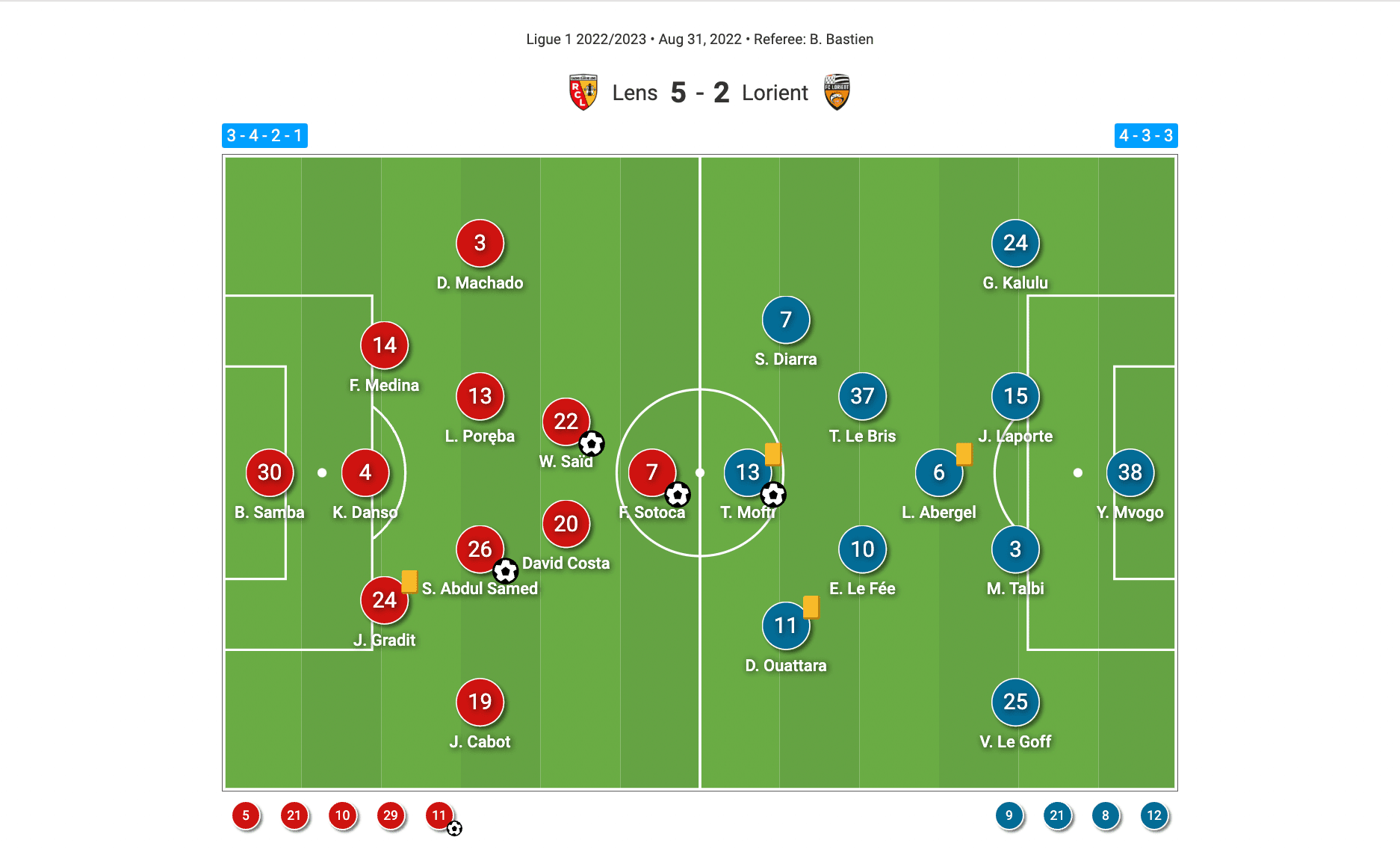
As shown in figure 1, Lens lined up in a 3-4-2-1 shape for this fixture — one of the more typical formations that Haise deploys with the 51-year-old coach having been a major advocate of a three-centre-back system throughout his time at Estadio Bollaert-Delelis.
Lens’ starting eleven was as follows; GK: Brice Samba, RCB: Jonathan Gradit, CB: Kevin Danso, LCB: Facundo Medina, RWB: Jimmy Cabot, LWB: Deiver Machado, RCM Salis Abdul Samed, LCM: Łukasz Poręba, RW: David Costa, LW: Wesley Saïd, CF: Florian Sotoca.
As for substitutes, Loïs Openda replaced the injured Saïd just before halftime, Przemysław Frankowski replaced Cabot in the 78th minute, Gaël Kakuta came on for Costa in the 79th minute, Christopher Wooh took Poręba’s spot in the 87th minute and Massadio Haïdara took over from Machado in the 87th minute.
Meanwhile, the away side lined up in a 4-3-3 shape for the majority of this game, with the starting XI consisting of; GK: Yvon Mvogo, RB: Gedeon Kalulu, RCB: Julien Laporte, LCB: Montassar Talbi, LB: Vincent Le Goff, RCM: Théo Le Bris, DM: Laurent Abergel, LCM: Enzo Le Fée, RW: Stéphane Diarra, LW: Dango Ouattara, CF: Moffi.
Throughout the game, Lorient made some substitutions. Firstly, in the 60th minute, Darlin Yongwa replaced Diarra, then in the 72nd minute Julien Ponceau came on for Le Bris before Bonke Innocent took over from Abergel in the 83rd minute. Lastly for Lorient, in the 84th minute, Ibrahima Koné replaced Ouattara in attack but Koné couldn’t make a difference to the result in this one.
Brilliant build-up/ball progression
The first area of strength from Lens’ performance in the last game that we’ll focus on in our analysis is their intelligent build-up play/ball progression. From a good structure to intelligent movement on and off the ball, this is an area in which Les Sang et Or have been excelling of late, including in Wednesday evening’s game versus Lorient.
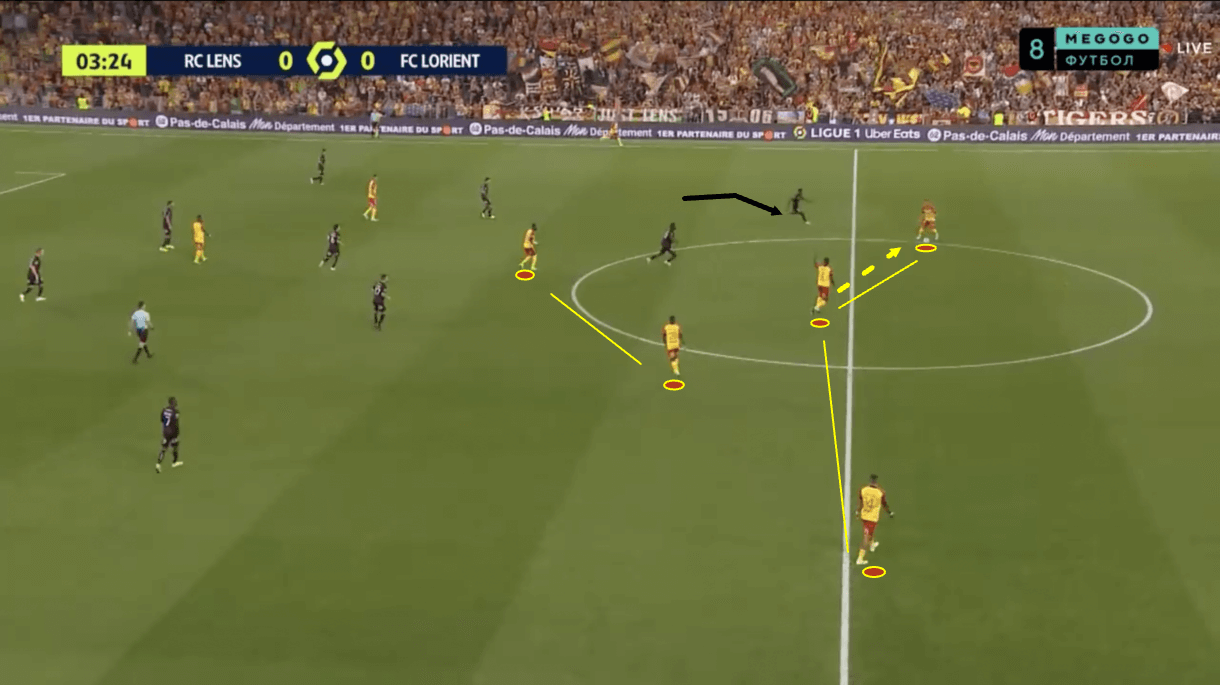
Figure 2 shows an example of Lens’ base structure in the ball progression phase, which is a phase we saw them in the majority of the time on Wednesday as Lorient defended quite deep, generally not pressing very high but defending in a deep block and not really applying any pressure until either the ball progressed well into their half or a specific pressing trigger (such as a backwards pass like we see in the image above) occurs to signal the start of their press.
Lorient tended to press quite intelligently when they did commit as we see in figure 2, where we see the left-winger curving his run to cut off the lane between the centre-back and wing-back immediately. This was a common sight in Wednesday’s game from Lorient which made life more difficult for Haise’s men.
However, Lens’ operated with a 3-1 / occasionally 3-2 structure that ultimately helped them to their dominant victory and Lorient’s passive 4-5-1 without the ball, which hoped to force counterattacking opportunities, struggled to cope with.
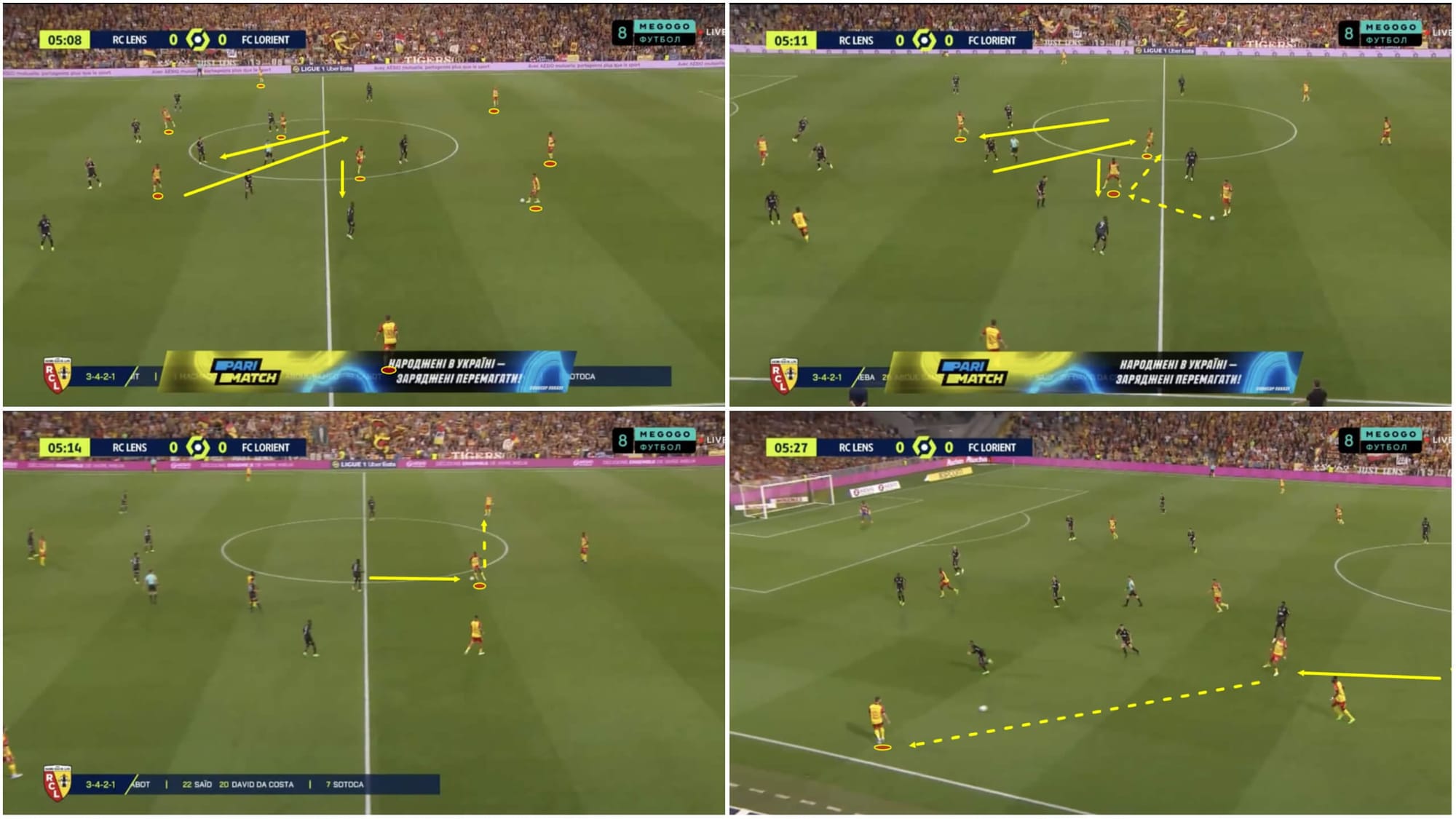
Two major reasons for that were, firstly, as we see in figure 3, Lens’ attacking players and midfield players were given a lot of freedom to roam about positionally provided they were remaining in a somewhat organised shape — it didn’t matter too much who was occupying which specific position in the system at all times beyond the initial 3-1 structure (three centre-backs and a holding midfielder — Samed).
In the top-left quartile above, we see Lens building an attack, with the holding midfielder dropping out wider, the more advanced central midfielder moving forward with a run and one of Lens’ attackers, then, dropping into his position to provide cover and a deeper passing option. We see how this move progresses in the top-right quartile, as Samed receives before immediately playing the ball sideways into the dropping attacker.
As play moves on in the bottom left and right quartiles, we see that this ultimately leads to the ball coming back across to the left centre-back who now has more space to carry it forward and play the through ball to the left wing-back.
However, the whole point of this move really was just to take risks, try and move the opposition about and forge openings in their defensive structure that enable Les Sang et Or to cut through them.
It was common to see lots of rotations like this from Lens in Wednesday’s game designed to exploit space and exploit Lorient’s position-oriented zonal marking system. Lens players could lose a marker and overload a specific zone alongside a teammate through these rotations as they wouldn’t be followed by Lorient’s defenders, which they tried to use to their advantage.
Lens’ front three were very fluid, in particular, in this game and it was common to see them popping up centrally or on either wing, providing options in behind or providing deep passing options. They had plenty of freedom to roam about and find ways of best influencing the game and we feel this creative freedom in terms of movement played an important role in their team’s impressive performance on Wednesday.
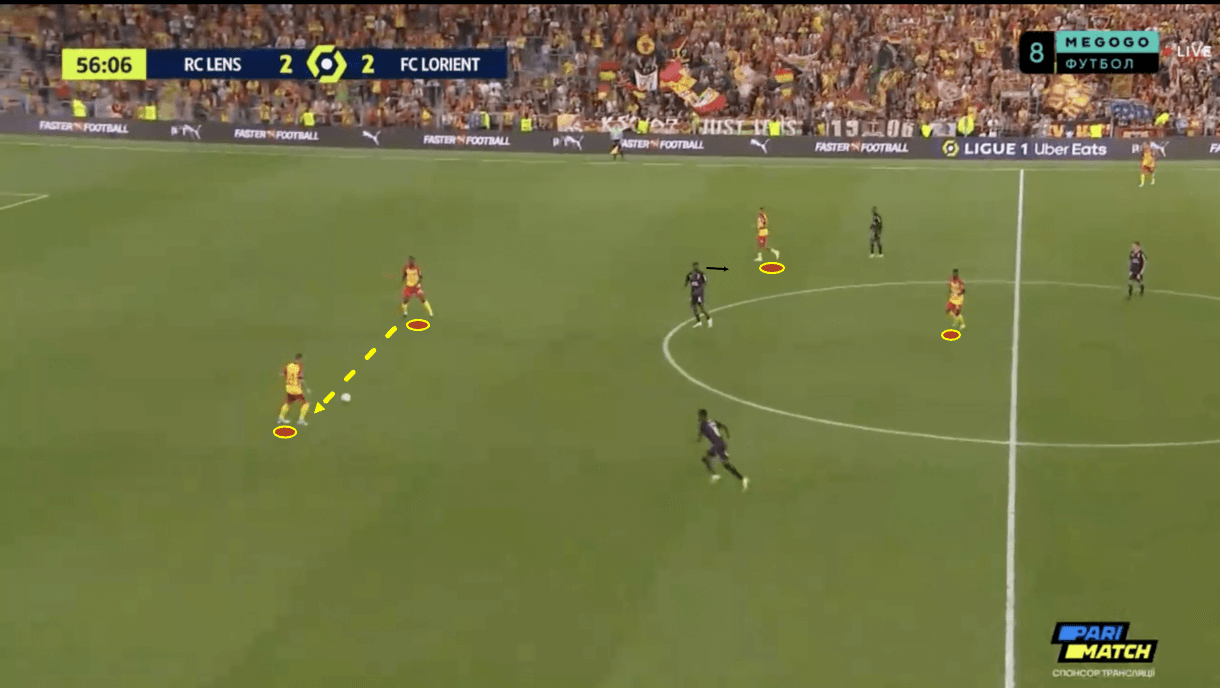
Lastly, Samed’s role as the holding midfielder was crucial for Lens’ success in build-up/ball progression. Samed is not a major ball progressor and isn’t someone you might even describe as a ‘direct threat’, in that regard. However, he’s great at making himself available for teammates, receiving under pressure and providing a link between teammates or just easing pressure on a player while performing a one-two passing combination.
Samed spent a large portion of the game for his possession-dominant side in the position we see him in figure 4, with his back to the opposition’s goal. Here, Lens’ right centre-back has just received the ball while Lorient’s striker is checking his shoulder to ensure Samed is under control.
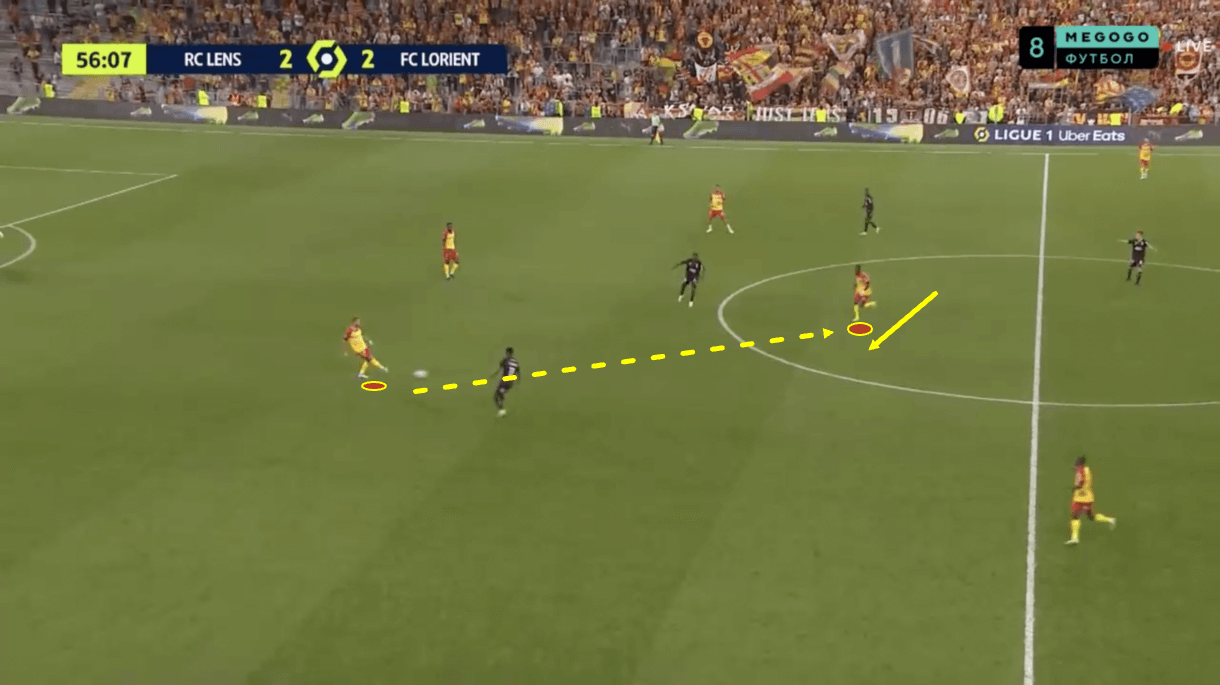
As play moves on just one second, though, we see that Samed has accelerated into space to provide the right centre-back with an option and create more room away from the striker. This intelligent movement facilitated some progress for Lens as the angle Samed forms helps Les Sang et Or to move from the right centre-back to the attacking midfielder dropping into space alongside the former Clermont Foot holding midfielder in figure 5. From there, they can continue to build the attack inside the opposition’s half.
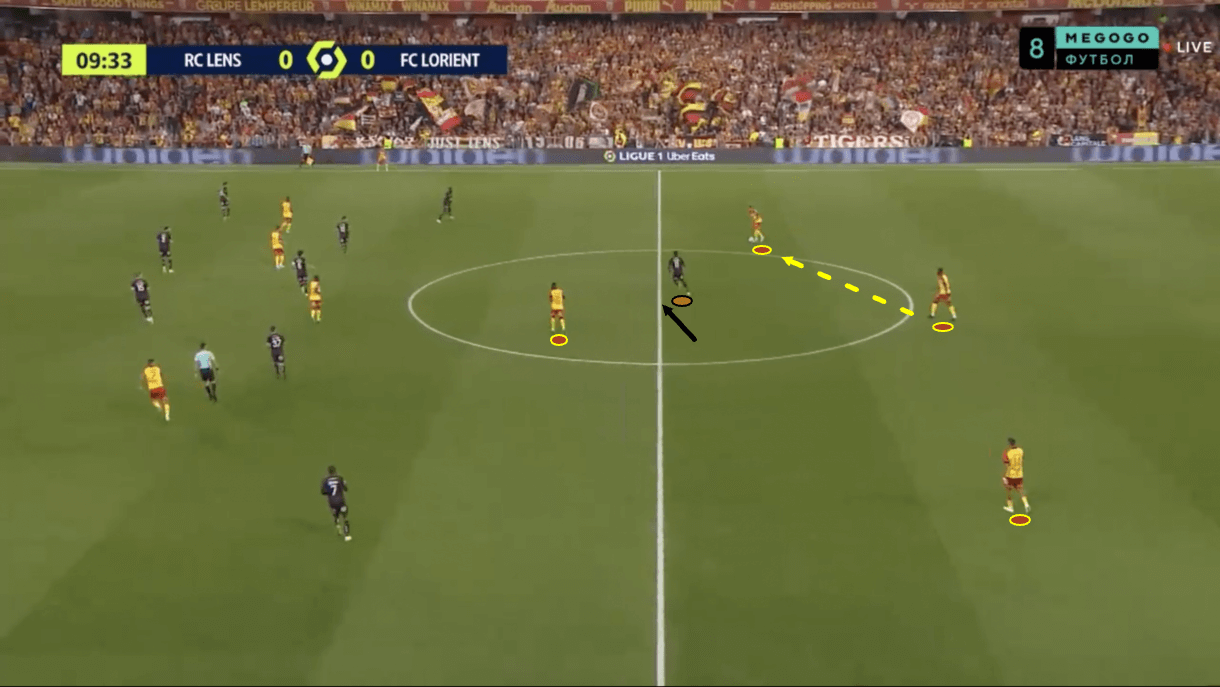
While Samed was reliable at receiving the ball under pressure and making himself available for teammates to link up with, at times Lens didn’t need to use him on the ball. On these occasions, the player simply being present in his holding midfield position was enough to help his team progress, as they could use him as something of a decoy.
Take figure 6, for example. Here, we see the right centre-back receiving again and this time the striker does a better job of keeping Samed in his cover shadow, blocking the pass into him.
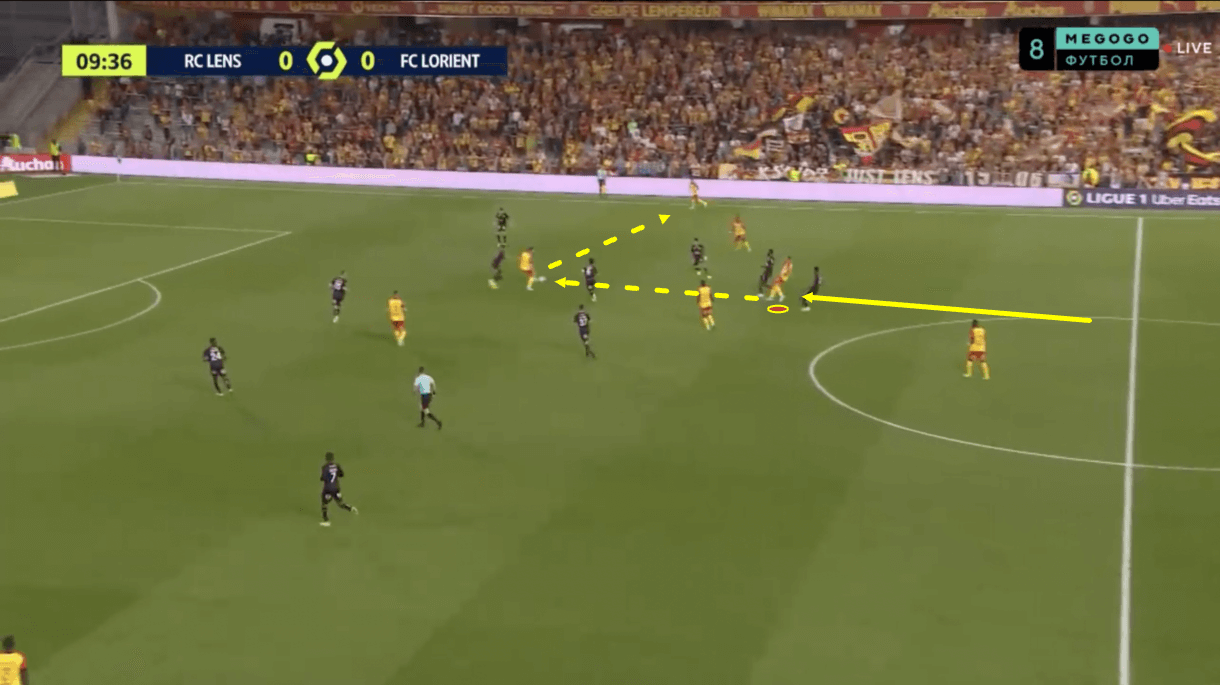
However, this keeps the lane at right central midfield open for the right centre-back to just carry the ball into himself until resistance is met and the opposition applies some pressure, at which point (as we see in figure 7) the player releases the forward pass into the right-winger’s feet.
After receiving the ball in the right half-space, the winger can link up with the overlapping wing-back on the right to progress Les Sang et Or into the final third — which leads us to our next section: wonderful wing play.
To close this section first, however, I hope we’ve clarified why we believe Lens’ build-up and ball progression was so instrumental in Wednesday’s victory, as the intelligent movement from the players within the structure Haise set up for them and their intelligent use of the holding midfielder who had a very important role in facilitating ball progression proved key in the game, for the reasons as described in this section.
Wonderful wing play
Wing play has always been an important aspect of Haise’s Lens, whether that be this season or in previous campaigns. Nevertheless, it certainly remains an important aspect of the team’s game in 2022/23 — especially in the chance creation phase — with Wednesday evening’s game providing a great example of how and why, as Lens used the wings heavily to break their opponents down time and time again in midweek.
Lorient couldn’t handle Lens’ use of the wings in midweek. This, combined with their fluid movement in central areas, made Haise’s side very difficult to deal with in possession as if it wasn’t an attacking midfielder dropping deep to overload the centre of the pitch you had to worry about, it might be that the defensive structure is being exploited for its lack of cover out wide via a great switch of play.
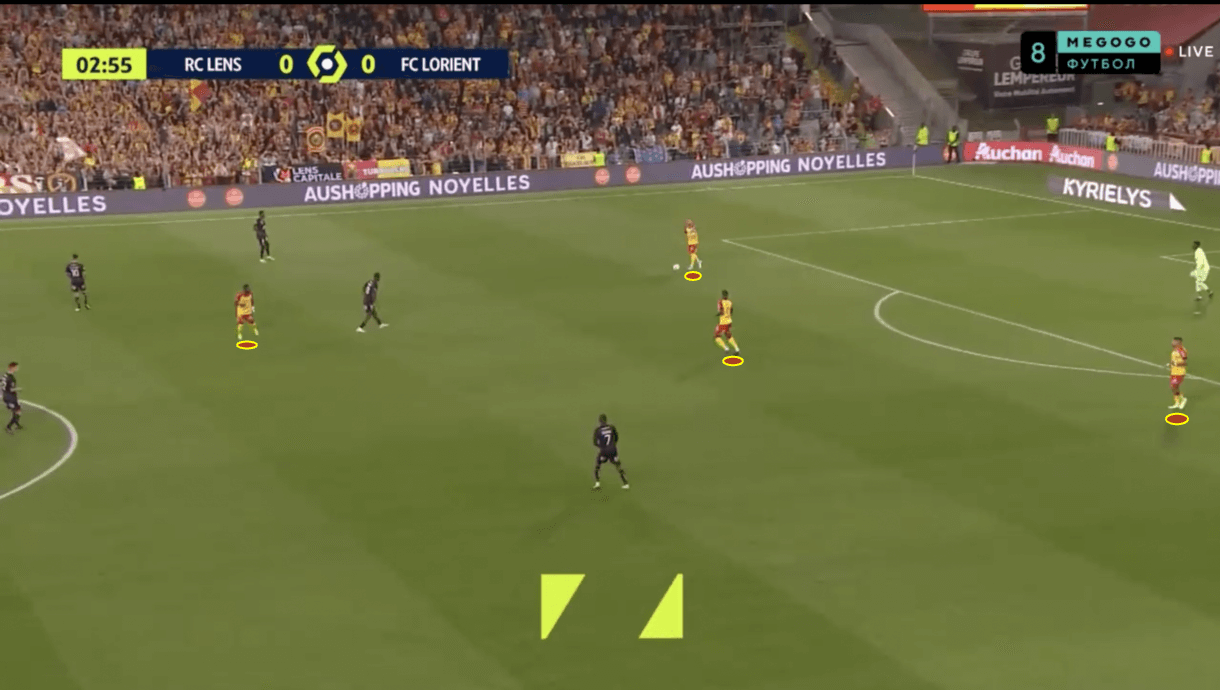
Take figures 8-9, for example. Here in figure 8, Lens’ right centre-back has just received the ball in the build-up phase. While the pass into Samed and central midfield is blocked by Lorient’s attackers, who aren’t pressing the backline aggressively which gives the right centre-back time and space to figure out what their next move is, the centre-back has another way of progressing upfield on his mind, which he scopes out in figure 8 by getting his head up and looking at the options ahead of him.
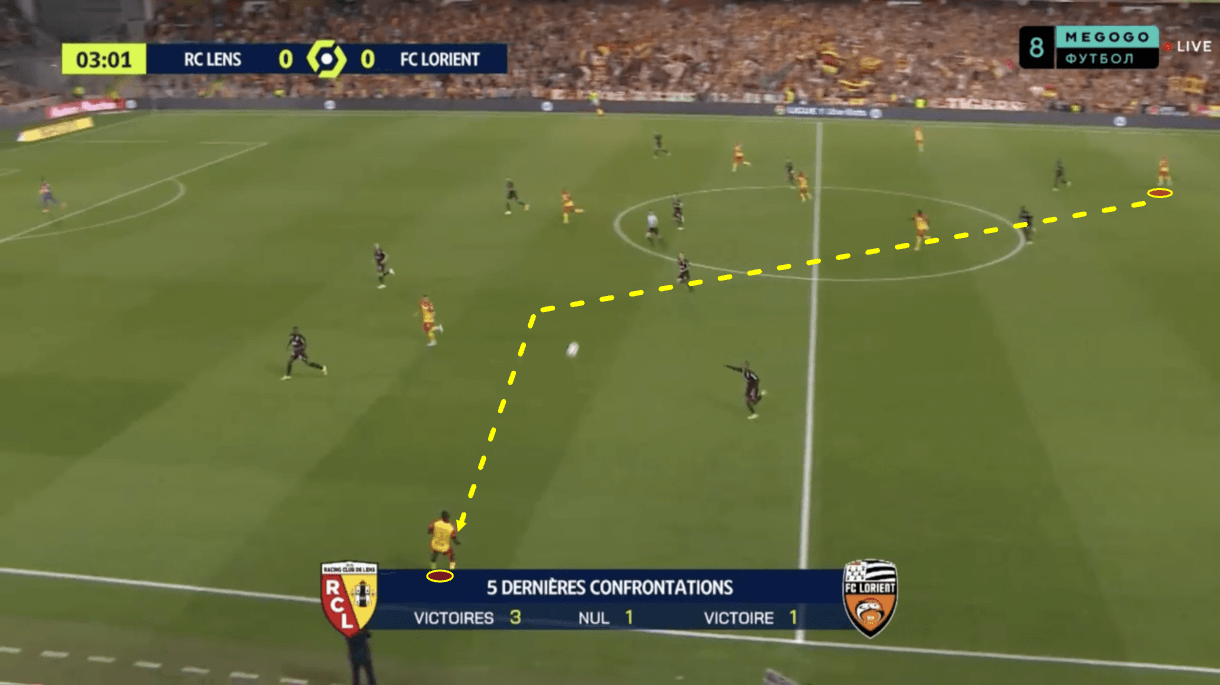
As we move on into figure 9, we see how the centre-back carried the ball forward a few more steps, continuing to push the opposition defence backwards before launching a crossfield ball to the left wing-back who’s positioned himself high on the opposite wing. This switch of play was perfectly weighted and put Lens in possession inside the opposition’s half with space to drive forward and trouble the opposition defence.
We saw a lot of switches like this one from Lens in Wednesday’s game; it’s something that’s built into Lens’ system and the minds and bodies of their players as muscle memory at this point. You only need to look at figure 9 and see how much space the wing-back has out wide to understand why this technique is such a prominent part of Les Sang et Or’s game.
The opposition prefers to sit narrower in their defensive structure, prioritising protection of the centre over protection of the wings. There’s logic to this in that the central zones are generally of higher value but it’s a dangerous game versus Lens, who drive so much of their attacking play through the wings and whose wing-backs are such a creative force in the system. Giving these players so much space to receive and drive forward is very risky, as Les Merlus found out in midweek.
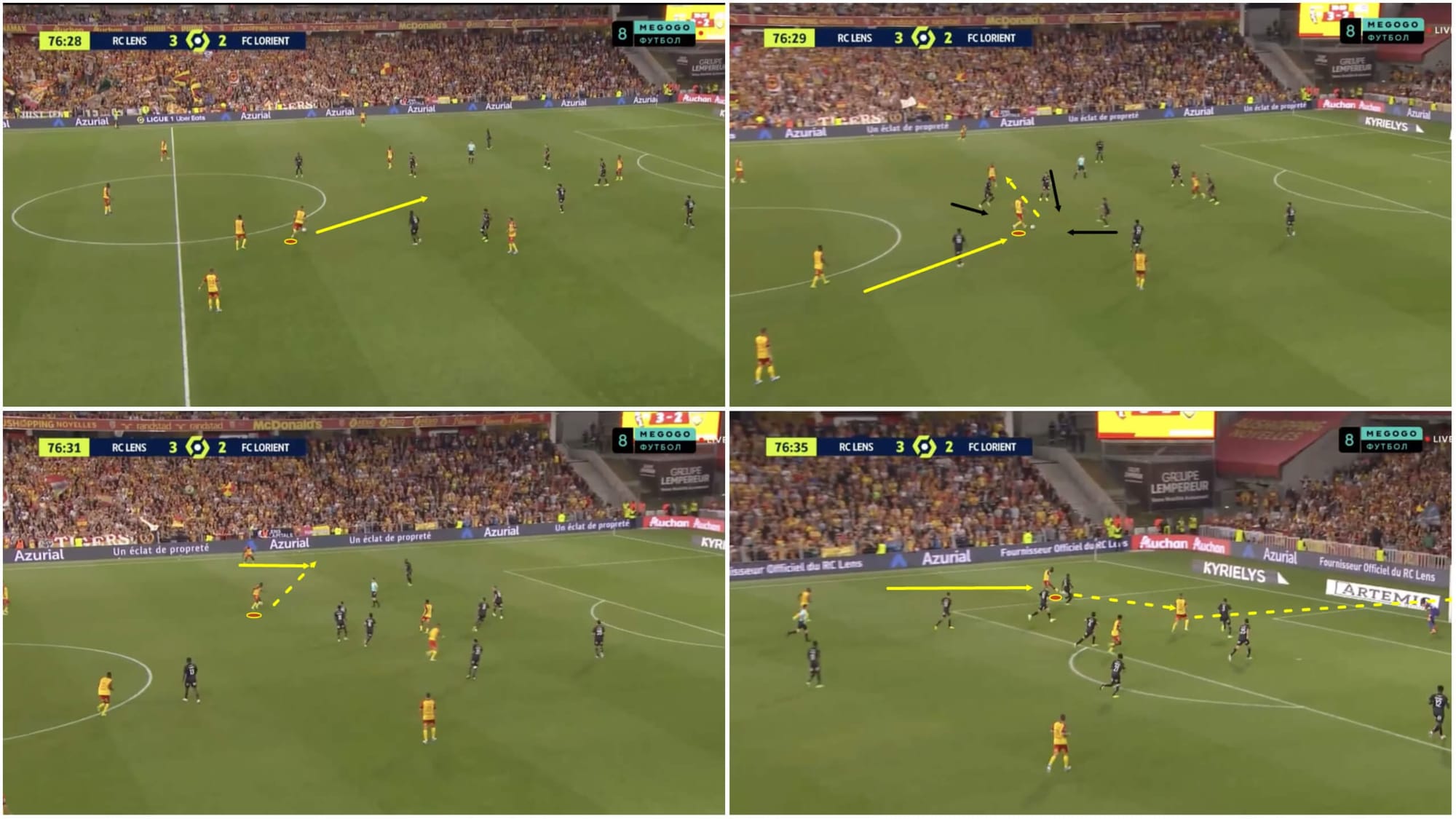
Most of Lens’ five goals in this game came as a result of some excellent wing play, including their fourth goal — the build-up of which is shown in figure 10. Firstly, in the upper-left quartile, one of Lens’ front three (striker Sotoca) has dropped deep to get on the ball and drive forward against Lorient’s low block from a deeper area.
After dribbling into a more advanced, central area, Sotoca has got surrounded by opposition bodies who are closing in around him. The attacker has attracted all these players in, demonstrating his ‘gravity’ or ability to create space elsewhere for teammates by pulling defenders in with his dribble.
As play moves on, Sotoca releases to the left central midfielder in space who can then link up with the overlapping left wing-back who’s got a lot of space on the left wing. After receiving, the left wing-back can advance to just outside the penalty area, carrying the ball into a good crossing position.
From here, Machado assists the fourth goal of the game as the cross meets the man who started this attack, Sotoca, inside the box who pulls off a beautiful first-time finish off the cross.
While the finish here was a thing of beauty, it’s important to recognise the move that led to it, and when we look at the move, we can see another example of Lens exploiting the width and their immense threat from wide areas. They attract players centrally first with the dribble, creating space out wide to then play into, getting one of their wing-backs on the ball who can set up a goal.
It’s key for Lens’ wing-backs to be good crossers, as is evident from this example, due to the team’s reliance on wing play.
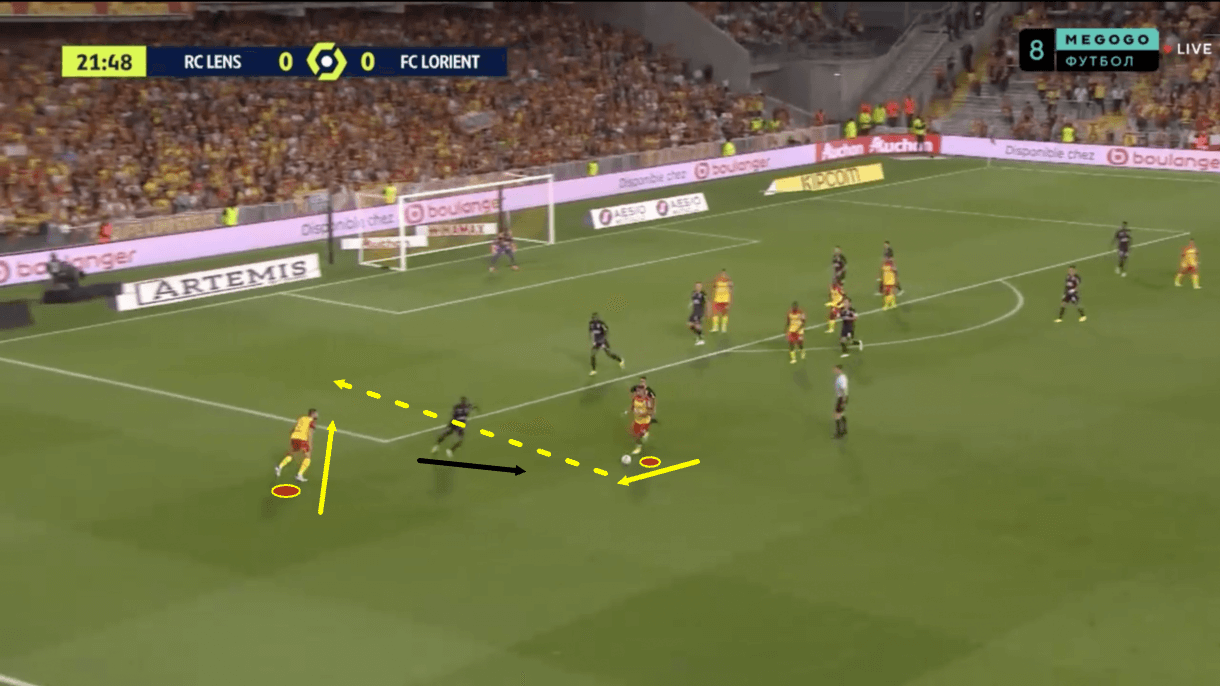
It was common to see Lens double-up on the opposition full-backs throughout this game, generally with the wing-back and winger on that particular side, though the winger positions on that side of the pitch would change frequently due to the heavy rotation in the forward line.
We see an example of this in figure 11. Here, the winger has received centrally and carried it into the half-space where we see him in the image. At this point, the ball carrier starts to attract attention from the opposition’s right-back, who starts to step out to close him down. This creates space in behind for the left wing-back to target and creates a great through passing opportunity for the ball carrier — an opportunity which he takes.
Again, this highlights Lens’ major focus on getting the wing-backs on the ball in dangerous chance-creating positions. These players are a key creative outlet for Les Sang et Or, and the important thing for Haise to focus on is thinking of creative ways of getting these players on the ball in dangerous positions where they can make something happen.
We’ve seen three such effective approaches to getting the wing-backs on the ball in creative positions from Wednesday’s game in this section of analysis 1. A big switch from the centre-back/midfielder on the opposite side of the pitch, 2. overloading/attracting the opposition to the centre of the pitch before then playing out to the wing where they should have now created some space for the team to play with and 3. Building into the final third centrally and creating a 2v1 overload on the opposition full-back with the winger and the wing-back.
These approaches were key to Lens’ attacking game versus Lorient, with wing play and the wing-backs, in particular, proving crucial to the dominant win.
Aggressive defensive tactics
For our final section of analysis on this game between Lens and Lorient, we’ll take a look at how Lens’ defensive tactics played an important role in Wednesday’s victory. Lens dominated the possession in this game, ending the contest with 58% of the ball to Lorient’s 42%.
Lens’ patient build-up to create openings for progression was important for this possession dominance, for sure, but the way in which Les Sang et Or defended was just as crucial in ensuring they kept as much of the ball as possible, which was important for Haise’s team to control the game in the way he wanted.
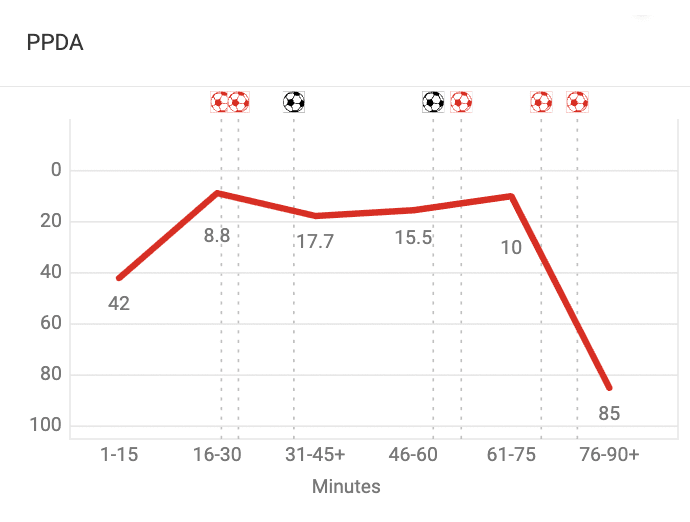
Figure 12 shows Lens’ PPDA over the 90-minute game, with the image broken up into 15-minute intervals. We can see from the image that Lens pressed quite aggressively for the majority of the game — especially during the periods when their first four goals came, with the fifth goal coming in a more orthodox counterattacking fashion after Lens had decided to sit off a little bit more and invite Lorient out while preserving energy in the final 15 minutes of the game after going two goals to the good.
There was a little bit of a dip in Lens’ pressing intensity towards the end of the first half, perhaps as they’d gone so intense over the rest of the half that they started to tire a little bit. It did seem as though fatigue played a factor in Lens’ pressing intensity dropping off towards the end of the first half.
They got their second wind in the second half, however, and this helped them to dominate Lorient to regain their two-goal lead and put the game beyond all doubt.
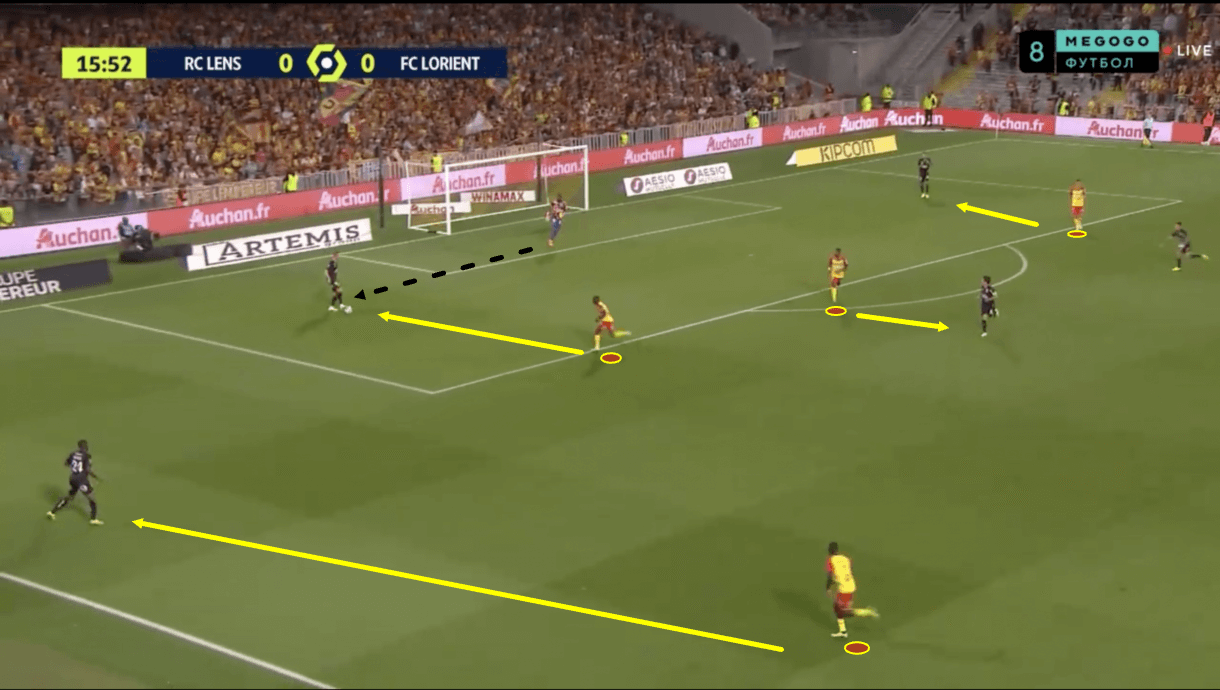
Lens defended with a man-oriented press, generally approaching the opposition right from their goal-kicks — a contrast to Lorient’s defensive approach as previously discussed. We see an example of this man-oriented pressing approach in figure 13.
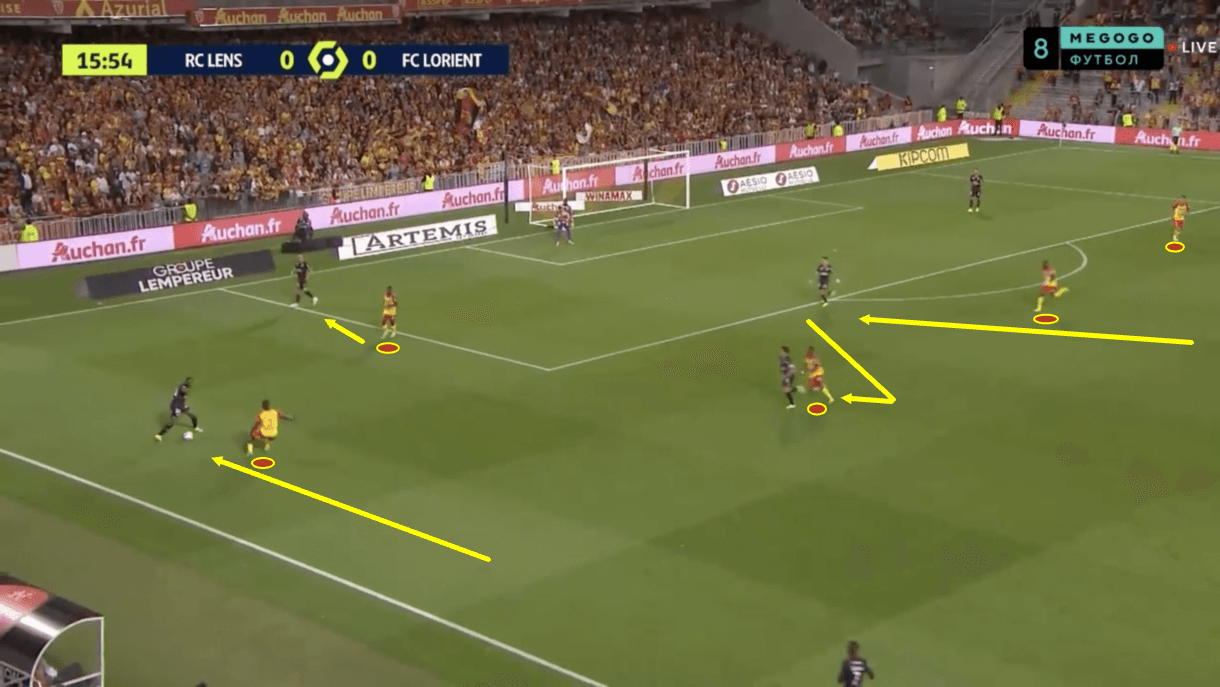
After blocking off all passes in central areas, Lens force the ball wide as play moves on into figure 14 but the receiver out wide is quickly met by Lens’ left wing-back who closes him down aggressively while blocking the passing lane to the winger further upfield.
Meanwhile, Lens’ front three remain tight to their corresponding men from the opposition’s build-up structure, while one of Lens’ central midfielders has been dragged high by an opponent’s decision to drop deep to try and provide an extra body for Lorient in the first phase — having recognised that Lens’ man-oriented press was putting his side in real danger.
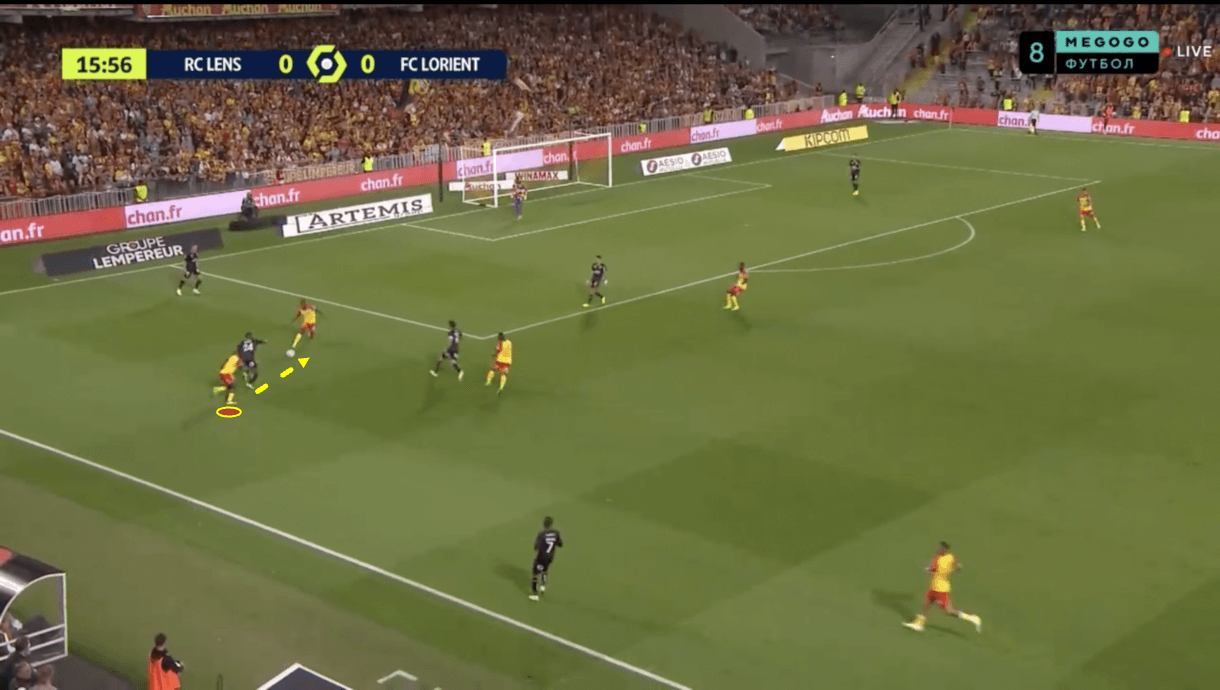
Les Sang et Or’s left wing-back does an excellent job of dispossessing the opposition’s ball carrier and getting the ball into the feet of his winger in figure 15. This sets up a great attacking opportunity for Lens on the edge of their opponent’s penalty area.
Lens tried to win back possession quickly and high upfield for the most part in this game. They wanted to create high transitions for their skilful forward line to capitalise on with their technical dribbling ability, pace and intelligent movement in the final third. Haise’s men created plenty of opportunities like this one in Wednesday’s game, stifling Lorient’s own possession play while creating good goalscoring opportunities for themselves.
On a few occasions, Lorient tried to go long to evade the pressure but this was largely unsuccessful. Their attackers were dominated in aerial duels by Lens’ defenders and attackers became isolated up top if they managed to take the ball down, leading to them getting swarmed by Lens’ defence.
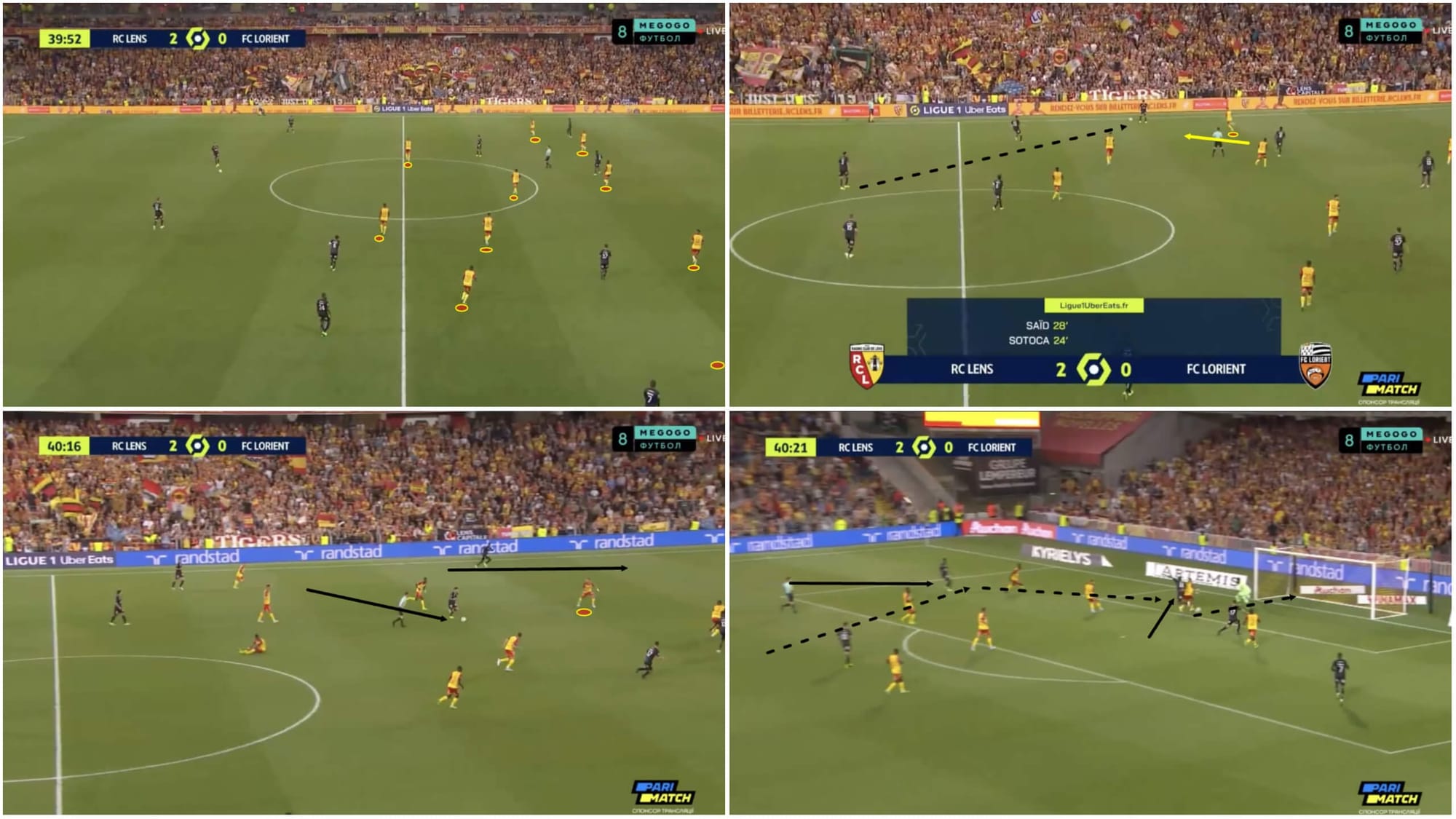
With that said, Lorient did have some joy targeting the space left open behind right wing-back Cabot in transition and in settled possession attacks, with Lorient’s first goal coming from a period of settled possession that dragged Cabot out from the defence and thus created space behind the wing-back for Les Merlus to exploit, depicted in figure 16.
As mentioned earlier, though, the real star of the show for Lorient and the reason this attack ended up successful was Moffi, whose offensive movement was top-notch in Wednesday’s game, giving Lens’ defence problems they just couldn’t handle. In the bottom-right quartile, we see that the striker moved in front of Lens’ centre-back, used his body against the defender’s and directed the low cross into the goal in a nonchalant manner that made it look as though this was all very easy — it looked that way because of the striker’s quality.
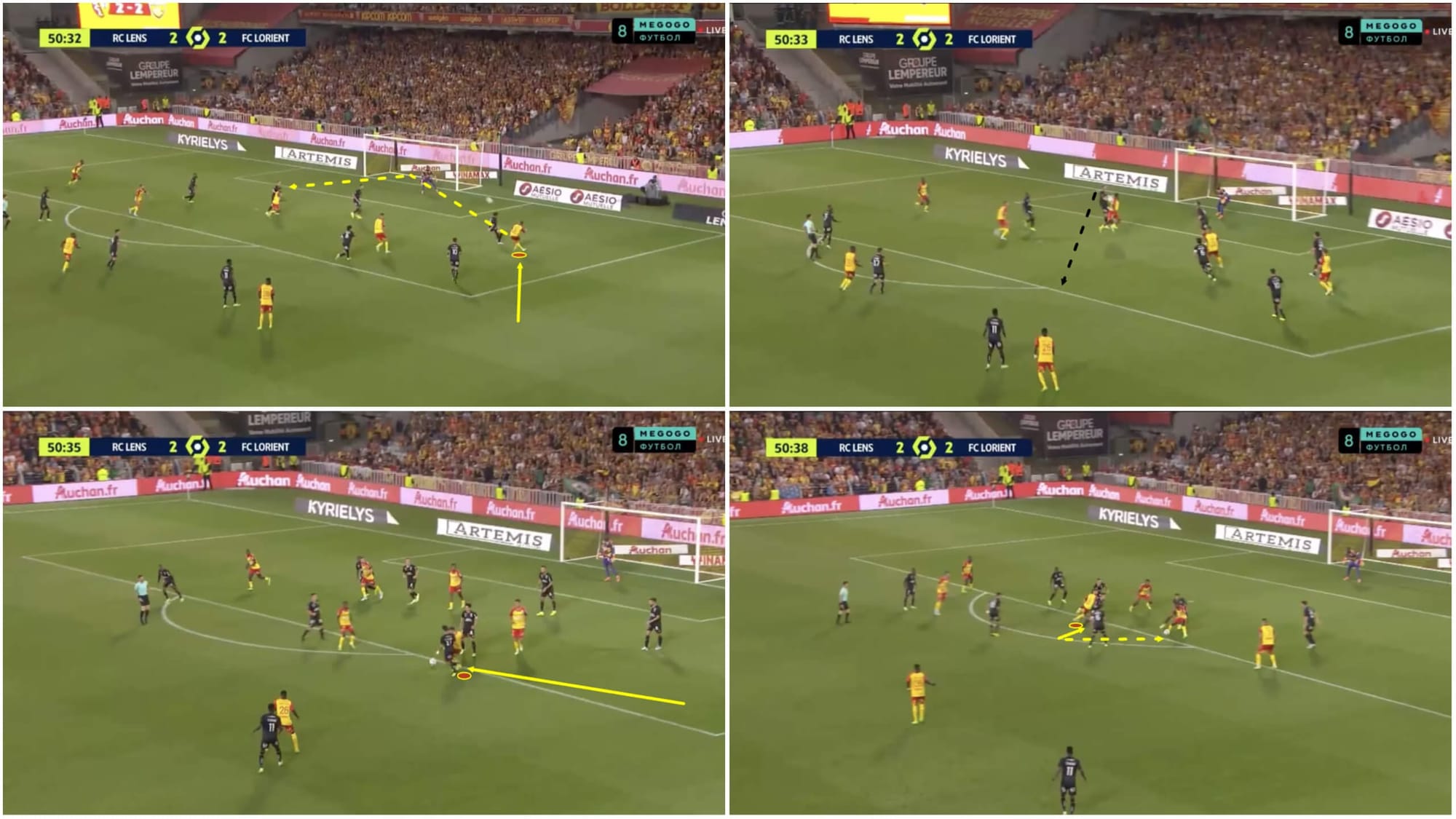
Lens’ attitude was excellent without the ball on Wednesday; they were generally quicker to react to loose balls and won a lot of the key 50/50 battles, while Lorient got a bit sloppy with the ball at times — perhaps a result of mental fatigue setting in after being subjected to the possession dominance and intelligent attacking moves of Haise’s team — which made life easier again for the generally alert and energetic Lens side.
This positive attitude was important for Lens’ success in counterpressing situations, such as the one we see in figure 17. Here, after Cabot crossed the ball into the box, it was duly headed away by Lorient’s centre-back.
The defender only managed to clear the ball to the edge of the area, though, and despite starting farther away from where the ball dropped, Cabot was able to get to the loose ball first, as we see in the bottom-left quartile in the image above.
From there, the right wing-back sent the ball back into the penalty box and tried to kickstart another attacking move for his side from an auspicious, dangerous position.
Again, Lorient had hoped to capitalise on counterattacking opportunities, primarily, in this game, and Lens’ main approach to counteracting this was their counterpressing. The energy, alertness and attitude of the midfield, wing-backs and front three had to be excellent to make this work and, in fairness, it was for the most part as was the case with Cabot here in this example, who was particularly useful in this area for Les Sang et Or in this game.
So, while Lorient were able to target space behind Cabot on occasion, and made a clear conscious effort to target Lens’ right wing-back, the 28-year-old did well when defending on the front foot farther upfield.
Conclusion
To conclude this tactical analysis, I hope it’s clear from our three sections what Lens’ three tactical keys to dominance were versus Lorient on Wednesday.
Firstly, they dominated Les Merlus with their intelligent build-up play and ball progression, including the possession structure itself and with the intelligent movement that occurred around it. Secondly, they dominated Lorient via their wing play, which was a key component of their attacking approach in midweek, and lastly, Lens dominated via their successful implementation of an aggressive defensive approach.
Lorient were onto something when they tried to target the space behind Cabot in settled periods of possession or on the counter but ultimately, Lens’ pressing/counterpressing was very effective and denied Les Merlus too many settled periods of possession/counterattacking opportunities anyway.
For us, Lens are one of the most impressive teams in France from a tactical perspective at present and with so much talent in their team, they’ll remain one to watch throughout the season.





Comments